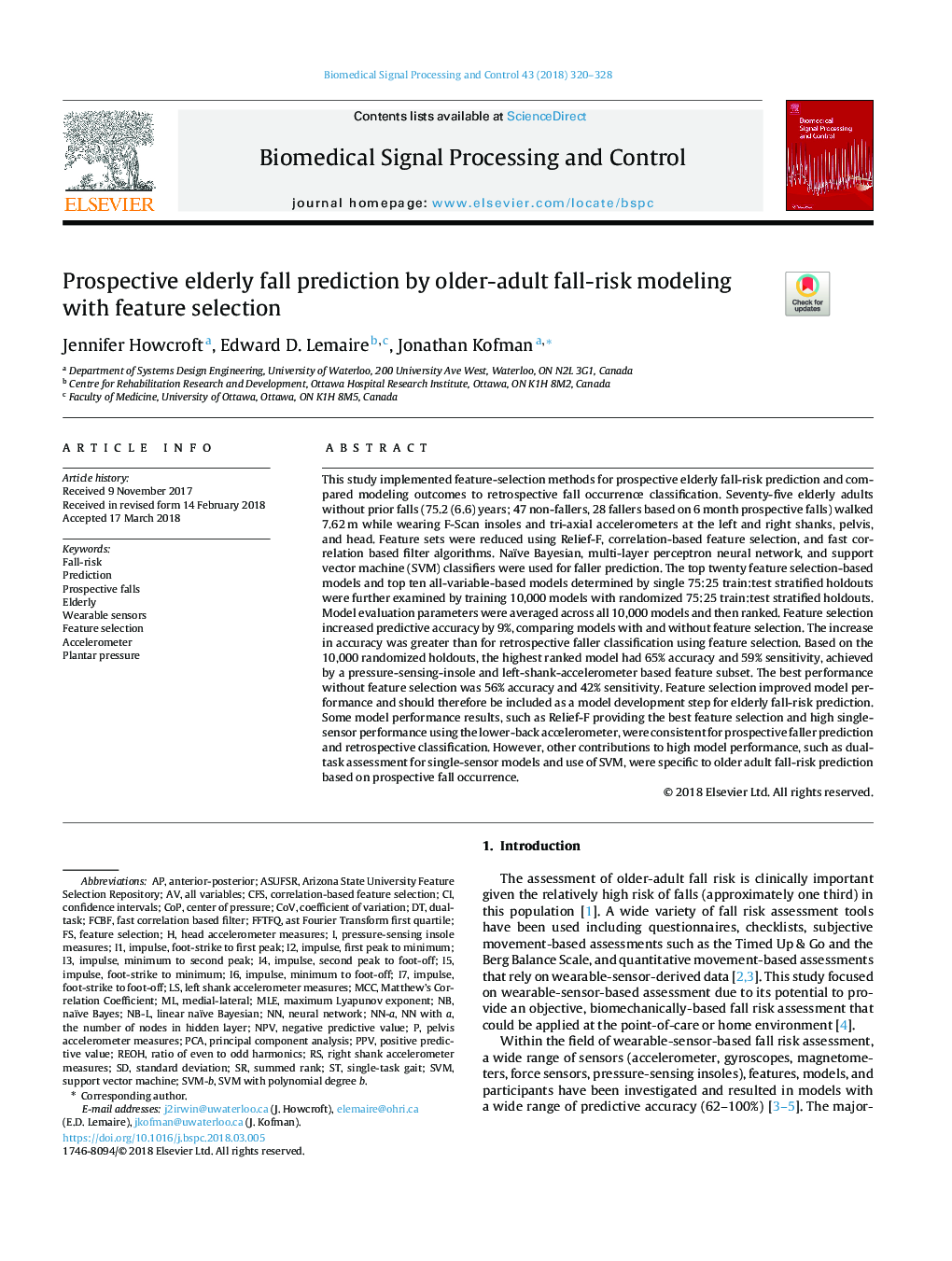| کد مقاله | کد نشریه | سال انتشار | مقاله انگلیسی | نسخه تمام متن |
|---|---|---|---|---|
| 6950871 | 1451637 | 2018 | 9 صفحه PDF | دانلود رایگان |
عنوان انگلیسی مقاله ISI
Prospective elderly fall prediction by older-adult fall-risk modeling with feature selection
ترجمه فارسی عنوان
پیش بینی سقوط آینده سالمندان با مدل سازی ریسک پاییز سالمندان با انتخاب ویژگی ها
دانلود مقاله + سفارش ترجمه
دانلود مقاله ISI انگلیسی
رایگان برای ایرانیان
کلمات کلیدی
MLENPVFall-riskCorrelation-based feature selectionPPVMCCCFSCOPNaïve Bayes - Bayes نائومیPCA - PCACOV - THEpositive predictive value - ارزش پیش بینی مثبتnegative predictive value - ارزش پیش بینی منفیFeature selection - انتخاب ویژگیstandard deviation - انحراف معیارPrincipal component analysis - تحلیل مولفههای اصلی یا PCAMaximum Lyapunov Exponent - حداکثر امتیاز لیاپانوفElderly - سالمندیWearable sensors - سنسورهای پوشیدنیNeural network - شبکه عصبیAccelerometer - شتاب سنجCoefficient of Variation - ضریب تغییرconfidence intervals - فاصله اطمینانPlantar pressure - فشار پاستارSVM - ماشین بردار پشتیبانیSupport vector machine - ماشین بردار پشتیبانیCenter of pressure - مرکز فشارmedial-lateral - میانی و جانبیAnterior-Posterior - پیش از عقبPrediction - پیش بینیDual-task - کار دوگانه
موضوعات مرتبط
مهندسی و علوم پایه
مهندسی کامپیوتر
پردازش سیگنال
چکیده انگلیسی
This study implemented feature-selection methods for prospective elderly fall-risk prediction and compared modeling outcomes to retrospective fall occurrence classification. Seventy-five elderly adults without prior falls (75.2 (6.6) years; 47 non-fallers, 28 fallers based on 6 month prospective falls) walked 7.62â¯m while wearing F-Scan insoles and tri-axial accelerometers at the left and right shanks, pelvis, and head. Feature sets were reduced using Relief-F, correlation-based feature selection, and fast correlation based filter algorithms. Naïve Bayesian, multi-layer perceptron neural network, and support vector machine (SVM) classifiers were used for faller prediction. The top twenty feature selection-based models and top ten all-variable-based models determined by single 75:25 train:test stratified holdouts were further examined by training 10,000 models with randomized 75:25 train:test stratified holdouts. Model evaluation parameters were averaged across all 10,000 models and then ranked. Feature selection increased predictive accuracy by 9%, comparing models with and without feature selection. The increase in accuracy was greater than for retrospective faller classification using feature selection. Based on the 10,000 randomized holdouts, the highest ranked model had 65% accuracy and 59% sensitivity, achieved by a pressure-sensing-insole and left-shank-accelerometer based feature subset. The best performance without feature selection was 56% accuracy and 42% sensitivity. Feature selection improved model performance and should therefore be included as a model development step for elderly fall-risk prediction. Some model performance results, such as Relief-F providing the best feature selection and high single-sensor performance using the lower-back accelerometer, were consistent for prospective faller prediction and retrospective classification. However, other contributions to high model performance, such as dual-task assessment for single-sensor models and use of SVM, were specific to older adult fall-risk prediction based on prospective fall occurrence.
ناشر
Database: Elsevier - ScienceDirect (ساینس دایرکت)
Journal: Biomedical Signal Processing and Control - Volume 43, May 2018, Pages 320-328
Journal: Biomedical Signal Processing and Control - Volume 43, May 2018, Pages 320-328
نویسندگان
Jennifer Howcroft, Edward D. Lemaire, Jonathan Kofman,
